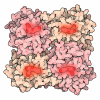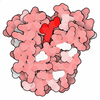+ Open data
Open data
- Basic information
Basic information
| Entry | Database: PDB / ID: 7wji | |||||||||||||||||||||||||||||||||||||||
|---|---|---|---|---|---|---|---|---|---|---|---|---|---|---|---|---|---|---|---|---|---|---|---|---|---|---|---|---|---|---|---|---|---|---|---|---|---|---|---|---|
| Title | Architecture of the human NALCN channelosome | |||||||||||||||||||||||||||||||||||||||
 Components Components |
| |||||||||||||||||||||||||||||||||||||||
 Keywords Keywords | MEMBRANE PROTEIN / ion channel / channelosome / NALCN | |||||||||||||||||||||||||||||||||||||||
| Function / homology |  Function and homology information Function and homology informationmonoatomic cation homeostasis / positive regulation of synaptic transmission, cholinergic / leak channel activity / viral tegument / regulation of resting membrane potential / cation channel complex / CaM pathway / Cam-PDE 1 activation / Sodium/Calcium exchangers / Calmodulin induced events ...monoatomic cation homeostasis / positive regulation of synaptic transmission, cholinergic / leak channel activity / viral tegument / regulation of resting membrane potential / cation channel complex / CaM pathway / Cam-PDE 1 activation / Sodium/Calcium exchangers / Calmodulin induced events / Reduction of cytosolic Ca++ levels / Activation of Ca-permeable Kainate Receptor / voltage-gated sodium channel activity / CREB1 phosphorylation through the activation of CaMKII/CaMKK/CaMKIV cascasde / Loss of phosphorylation of MECP2 at T308 / CREB1 phosphorylation through the activation of Adenylate Cyclase / CaMK IV-mediated phosphorylation of CREB / PKA activation / negative regulation of high voltage-gated calcium channel activity / Glycogen breakdown (glycogenolysis) / CLEC7A (Dectin-1) induces NFAT activation / Activation of RAC1 downstream of NMDARs / negative regulation of ryanodine-sensitive calcium-release channel activity / organelle localization by membrane tethering / mitochondrion-endoplasmic reticulum membrane tethering / autophagosome membrane docking / negative regulation of calcium ion export across plasma membrane / regulation of cardiac muscle cell action potential / presynaptic endocytosis / sodium channel activity / Synthesis of IP3 and IP4 in the cytosol / regulation of cell communication by electrical coupling involved in cardiac conduction / Phase 0 - rapid depolarisation / calcineurin-mediated signaling / Negative regulation of NMDA receptor-mediated neuronal transmission / Unblocking of NMDA receptors, glutamate binding and activation / RHO GTPases activate PAKs / Ion transport by P-type ATPases / Uptake and function of anthrax toxins / regulation of ryanodine-sensitive calcium-release channel activity / calcium ion import across plasma membrane / Long-term potentiation / protein phosphatase activator activity / Calcineurin activates NFAT / Regulation of MECP2 expression and activity / DARPP-32 events / catalytic complex / monoatomic ion channel complex / Smooth Muscle Contraction / detection of calcium ion / regulation of cardiac muscle contraction / RHO GTPases activate IQGAPs / regulation of cardiac muscle contraction by regulation of the release of sequestered calcium ion / monoatomic cation channel activity / cellular response to interferon-beta / Protein methylation / calcium channel inhibitor activity / presynaptic cytosol / Activation of AMPK downstream of NMDARs / Ion homeostasis / regulation of release of sequestered calcium ion into cytosol by sarcoplasmic reticulum / eNOS activation / titin binding / Tetrahydrobiopterin (BH4) synthesis, recycling, salvage and regulation / sperm midpiece / regulation of calcium-mediated signaling / voltage-gated potassium channel complex / potassium ion transmembrane transport / calcium channel complex / substantia nigra development / sodium ion transmembrane transport / FCERI mediated Ca+2 mobilization / Ras activation upon Ca2+ influx through NMDA receptor / regulation of heart rate / FCGR3A-mediated IL10 synthesis / calyx of Held / Antigen activates B Cell Receptor (BCR) leading to generation of second messengers / adenylate cyclase activator activity / bioluminescence / sarcomere / VEGFR2 mediated cell proliferation / regulation of cytokinesis / protein serine/threonine kinase activator activity / VEGFR2 mediated vascular permeability / positive regulation of synaptic transmission, GABAergic / spindle microtubule / calcium channel regulator activity / Translocation of SLC2A4 (GLUT4) to the plasma membrane / generation of precursor metabolites and energy / positive regulation of receptor signaling pathway via JAK-STAT / Stimuli-sensing channels / RAF activation / Transcriptional activation of mitochondrial biogenesis / response to calcium ion / calcium ion transmembrane transport / RAS processing / cellular response to type II interferon / G2/M transition of mitotic cell cycle / long-term synaptic potentiation / spindle pole Similarity search - Function | |||||||||||||||||||||||||||||||||||||||
| Biological species |  Homo sapiens (human) Homo sapiens (human) | |||||||||||||||||||||||||||||||||||||||
| Method | ELECTRON MICROSCOPY / single particle reconstruction / cryo EM / Resolution: 4.5 Å | |||||||||||||||||||||||||||||||||||||||
 Authors Authors | Wu, J.P. / Yan, Z. / Zhou, L. / Liu, H. / Zhao, Q. | |||||||||||||||||||||||||||||||||||||||
| Funding support | 1items
| |||||||||||||||||||||||||||||||||||||||
 Citation Citation |  Journal: Cell Discov / Year: 2022 Journal: Cell Discov / Year: 2022Title: Architecture of the human NALCN channelosome. Authors: Lunni Zhou / Haobin Liu / Qingqing Zhao / Jianping Wu / Zhen Yan /  Abstract: NALCN regulates the resting membrane potential by mediating the Na leak current in neurons, and it functions as a channelosome in complex with FAM155A, UNC79, and UNC80. Dysfunction of the NALCN ...NALCN regulates the resting membrane potential by mediating the Na leak current in neurons, and it functions as a channelosome in complex with FAM155A, UNC79, and UNC80. Dysfunction of the NALCN channelosome causes a broad range of neurological and developmental diseases called NALCN channelopathies in humans. How the auxiliary subunits, especially the two large components UNC79 and UNC80, assemble with NALCN and regulate its function remains unclear. Here we report an overall architecture of the human NALCN channelosome. UNC79 and UNC80 each adopt an S-shape super-helical structure consisting of HEAT and armadillo repeats, forming a super-coiled heterodimeric assembly in the cytoplasmic side, which may provide a scaffold for the binding of other potential modulators of the channelosome. The UNC79-UNC80 assembly specifically associates with the NALCN-FAM155A subcomplex through the intracellular II-III linker of NALCN. Disruptions of the interaction interfaces between UNC79 and UNC80, and between the II-III linker of NALCN and the UNC79-UNC80 assembly, significantly reduce the NALCN-mediated currents in HEK293T system, suggesting the importance of the UNC79-UNC80 assembly in regulating channelosome function. Cross-linking mass spectrometry analysis identified an additional calmodulin (CaM) bound in the carboxyl-terminal domain of NALCN. Our study thus provides a structural basis for understanding the unique assembly mechanism and functional regulation of the NALCN channelosome, and also provides an opportunity for the interpretation of many disease-related mutations in UNC80. | |||||||||||||||||||||||||||||||||||||||
| History |
|
- Structure visualization
Structure visualization
| Structure viewer | Molecule:  Molmil Molmil Jmol/JSmol Jmol/JSmol |
|---|
- Downloads & links
Downloads & links
- Download
Download
| PDBx/mmCIF format |  7wji.cif.gz 7wji.cif.gz | 968.1 KB | Display |  PDBx/mmCIF format PDBx/mmCIF format |
|---|---|---|---|---|
| PDB format |  pdb7wji.ent.gz pdb7wji.ent.gz | 755.5 KB | Display |  PDB format PDB format |
| PDBx/mmJSON format |  7wji.json.gz 7wji.json.gz | Tree view |  PDBx/mmJSON format PDBx/mmJSON format | |
| Others |  Other downloads Other downloads |
-Validation report
| Summary document |  7wji_validation.pdf.gz 7wji_validation.pdf.gz | 1.3 MB | Display |  wwPDB validaton report wwPDB validaton report |
|---|---|---|---|---|
| Full document |  7wji_full_validation.pdf.gz 7wji_full_validation.pdf.gz | 1.3 MB | Display | |
| Data in XML |  7wji_validation.xml.gz 7wji_validation.xml.gz | 137.9 KB | Display | |
| Data in CIF |  7wji_validation.cif.gz 7wji_validation.cif.gz | 212 KB | Display | |
| Arichive directory |  https://data.pdbj.org/pub/pdb/validation_reports/wj/7wji https://data.pdbj.org/pub/pdb/validation_reports/wj/7wji ftp://data.pdbj.org/pub/pdb/validation_reports/wj/7wji ftp://data.pdbj.org/pub/pdb/validation_reports/wj/7wji | HTTPS FTP |
-Related structure data
| Related structure data |  32544MC M: map data used to model this data C: citing same article ( |
|---|---|
| Similar structure data | Similarity search - Function & homology  F&H Search F&H Search |
- Links
Links
- Assembly
Assembly
| Deposited unit | 
|
|---|---|
| 1 |
|
- Components
Components
| #1: Protein | Mass: 363856.188 Da / Num. of mol.: 1 Source method: isolated from a genetically manipulated source Source: (gene. exp.)  Homo sapiens (human) / Gene: UNC80, C2orf21, KIAA1843 / Production host: Homo sapiens (human) / Gene: UNC80, C2orf21, KIAA1843 / Production host:  Homo sapiens (human) / References: UniProt: Q8N2C7 Homo sapiens (human) / References: UniProt: Q8N2C7 |
|---|---|
| #2: Protein | Mass: 298239.656 Da / Num. of mol.: 1 Source method: isolated from a genetically manipulated source Source: (gene. exp.)  Homo sapiens (human) / Gene: UNC79, KIAA1409 / Production host: Homo sapiens (human) / Gene: UNC79, KIAA1409 / Production host:  Homo sapiens (human) / References: UniProt: Q9P2D8 Homo sapiens (human) / References: UniProt: Q9P2D8 |
| #3: Protein | Mass: 16852.545 Da / Num. of mol.: 1 Source method: isolated from a genetically manipulated source Source: (gene. exp.)  Homo sapiens (human) / Gene: CALM1, CALM, CAM, CAM1 / Production host: Homo sapiens (human) / Gene: CALM1, CALM, CAM, CAM1 / Production host:  Homo sapiens (human) / References: UniProt: P0DP23 Homo sapiens (human) / References: UniProt: P0DP23 |
| #4: Protein | Mass: 229017.703 Da / Num. of mol.: 1 Source method: isolated from a genetically manipulated source Source: (gene. exp.)  Homo sapiens (human) / Gene: NALCN, VGCNL1, UL32 / Production host: Homo sapiens (human) / Gene: NALCN, VGCNL1, UL32 / Production host:  Homo sapiens (human) / References: UniProt: Q8IZF0, UniProt: A0A076JQ90 Homo sapiens (human) / References: UniProt: Q8IZF0, UniProt: A0A076JQ90 |
| #5: Protein | Mass: 51550.484 Da / Num. of mol.: 1 Source method: isolated from a genetically manipulated source Source: (gene. exp.)  Homo sapiens (human) / Gene: FAM155A / Production host: Homo sapiens (human) / Gene: FAM155A / Production host:  Homo sapiens (human) / References: UniProt: B1AL88 Homo sapiens (human) / References: UniProt: B1AL88 |
| Has protein modification | N |
-Experimental details
-Experiment
| Experiment | Method: ELECTRON MICROSCOPY |
|---|---|
| EM experiment | Aggregation state: PARTICLE / 3D reconstruction method: single particle reconstruction |
- Sample preparation
Sample preparation
| Component | Name: NALCN channelosome / Type: COMPLEX / Details: NALCN-FAM155A-UNC79-UNC80-CaM / Entity ID: all / Source: RECOMBINANT |
|---|---|
| Molecular weight | Value: 0.9 MDa / Experimental value: NO |
| Source (natural) | Organism:  Homo sapiens (human) Homo sapiens (human) |
| Source (recombinant) | Organism:  Homo sapiens (human) Homo sapiens (human) |
| Buffer solution | pH: 7.4 |
| Specimen | Conc.: 0.1 mg/ml / Embedding applied: NO / Shadowing applied: NO / Staining applied: NO / Vitrification applied: YES |
| Specimen support | Grid material: COPPER / Grid mesh size: 300 divisions/in. / Grid type: Quantifoil R1.2/1.3 |
| Vitrification | Cryogen name: ETHANE / Humidity: 100 % / Chamber temperature: 281 K |
- Electron microscopy imaging
Electron microscopy imaging
| Experimental equipment |  Model: Titan Krios / Image courtesy: FEI Company |
|---|---|
| Microscopy | Model: FEI TITAN KRIOS |
| Electron gun | Electron source:  FIELD EMISSION GUN / Accelerating voltage: 300 kV / Illumination mode: FLOOD BEAM FIELD EMISSION GUN / Accelerating voltage: 300 kV / Illumination mode: FLOOD BEAM |
| Electron lens | Mode: BRIGHT FIELD / Nominal magnification: 81000 X / Nominal defocus max: 2000 nm / Nominal defocus min: 1400 nm / Cs: 2.7 mm |
| Specimen holder | Cryogen: NITROGEN / Specimen holder model: FEI TITAN KRIOS AUTOGRID HOLDER |
| Image recording | Electron dose: 50 e/Å2 / Film or detector model: GATAN K3 (6k x 4k) |
- Processing
Processing
| Software | Name: PHENIX / Version: 1.17.1_3660: / Classification: refinement | ||||||||||||||||||||||||
|---|---|---|---|---|---|---|---|---|---|---|---|---|---|---|---|---|---|---|---|---|---|---|---|---|---|
| EM software | Name: PHENIX / Category: model refinement | ||||||||||||||||||||||||
| CTF correction | Type: PHASE FLIPPING AND AMPLITUDE CORRECTION | ||||||||||||||||||||||||
| 3D reconstruction | Resolution: 4.5 Å / Resolution method: FSC 0.143 CUT-OFF / Num. of particles: 174294 / Algorithm: FOURIER SPACE / Symmetry type: POINT | ||||||||||||||||||||||||
| Refine LS restraints |
|
 Movie
Movie Controller
Controller



 PDBj
PDBj






















